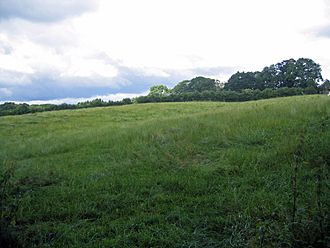Kelsborrow Castle facts for kids
Quick facts for kids Kelsborrow Castle |
|
|---|---|

The former ramparts of Kelsborrow Castle
|
|
| General information | |
| Architectural style | Iron Age hillfort |
| Country | England |
| Coordinates | 53°12′12″N 2°42′08″W / 53.2034°N 2.702097°W |
| Technical details | |
| Size | 9 acres (4 ha) |
Kelsborrow Castle is an ancient hill fort from the Iron Age in Cheshire, northern England. Hill forts were like fortified villages built on top of hills across Britain during the Iron Age. This particular one is special because it's one of only seven hill forts found in Cheshire.
Archaeologists believe Kelsborrow Castle was used for a short time. In the 1800s, a bronze tool called a palstave was found here. Today, Kelsborrow Castle is a protected site known as a Scheduled Ancient Monument. This means it's an important historical place that is kept safe.
Contents
What are Hill Forts?
Hill forts first appeared around 1000 BC, during the Late Bronze Age and Early Iron Age. People built them on hills for different reasons. Some experts think they were military sites, built to defend against invaders. Others believe they were built because more people were living in Britain, which led to arguments over land and food.
One popular idea is that when people started using iron more, society changed. Iron ore was found in different places than the metals used for bronze. This shifted trade routes and changed who held power. Archaeologist Barry Cunliffe suggests that these forts offered safety when conflicts broke out. He believes they weren't always built for war, but they could be used for defense when needed.
Where is Kelsborrow Castle?
There are over 1,300 hill forts in England, but most are in the south. Cheshire has only seven. Kelsborrow Castle is part of a small group of three Iron Age hill forts. The others are Eddisbury and Oakmere. These three forts are close to each other, within 3 miles (5 km).
They are all near the Mouldsworth Gap, which is a break in the central ridge of Cheshire. Kelsborrow Castle sits about 400 feet (120 m) above sea level. From the site, you can see the wide Cheshire Plain to the west, south-west, and south. There is higher ground just to the east of the castle.
How Kelsborrow Castle was Built
Kelsborrow Castle is a type of promontory fort. This means it uses the natural steep slopes of the hill to help with defense. The site is surrounded by a man-made bank and a ditch. However, there's a gap in the ditch on the west side, about 400 feet (120 m) long. This is probably because the ground there is already very steep.
The best parts of the bank that still exist are about 6 feet (1.8 m) high. The distance from the outside edge of the ditch to the inside edge of the bank is about 100 feet (30 m). The defenses cover about 1.75 acres (0.71 ha), and the area inside the fort is about 7.25 acres (2.93 ha).
The main entrance to the fort was likely in the south-east. Some hill forts have many layers of banks and ditches, called "multivallate." Kelsborrow Castle is "single vallate," meaning it has only one bank and ditch. This suggests it was a "one-phase" site, used for a short period. It's similar to other hill forts in Cheshire, like Bradley and Oakmere, and also to Castercliff and Portfield in Lancashire.
Protecting Kelsborrow Castle Today
Scientists have used special tools, like geophysical surveys, and done small archaeological digs in 1973 and 1996. These studies suggest there might be hidden structures, like storage pits, buried inside the hill fort.
The site is part of farmland, and it faces threats from vehicles and farm animals. Animal burrows and the growth of plants like bracken also cause damage. While Kelsborrow Castle is currently considered "at low risk," a recent study has suggested changing its status to "at high risk." This is because of activities like ploughing near the site. Five of Cheshire's hill forts are now considered "at high risk," which is a higher percentage than other protected sites in the North West of England.

